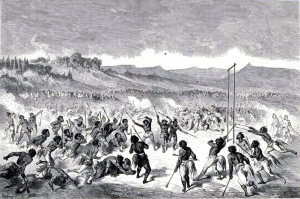5. Little Brothers of War: Ball games in Pre-Colombian North America
Maybe the Corinthian values that would later be applied to football were not devised within England’s finest academic walls, but among the wigwams and totem poles of the great plains of North America.
 The Mesoamerican ballgame was not the only one played in Pre-Colombian America. From California to Greenland, almost every native nation played some kind of ball sport, although rather than ballparks, the North American variants were invariably played out in the open.
The Mesoamerican ballgame was not the only one played in Pre-Colombian America. From California to Greenland, almost every native nation played some kind of ball sport, although rather than ballparks, the North American variants were invariably played out in the open.
The games played by the Algonquian in the northeast (such as pasuckuakohowog, meaning ‘they gather to play ball with the foot’) were almost identical to the kind of folk football being played in Europe at the same time, in which the ball was kicked through goals. But although the Europeans considered themselves to be the ‘civilised’ people and the Indians to be ‘savages’, almost every one of the many descriptions of Native American football expressed surprise at how much less brutal it was compared to the way the Europeans played it, such as one from 1612 saying that “they never strike up one another’s heeles, as we do, not accompting that praiseworthie to purchase a goale by such an advantage.”
 Folk football in Europe was still a vulgar, violent game and perhaps it was contact with the Native American game that first taught the Europeans that when played in a more orderly fashion, there were actually many benefits to be gained from it.
Folk football in Europe was still a vulgar, violent game and perhaps it was contact with the Native American game that first taught the Europeans that when played in a more orderly fashion, there were actually many benefits to be gained from it.
The popular image of Native American football being a murderously bloodthirsty sport is clearly misguided, and probably comes from confusion with the epic stickball games that were played throughout the continent and answered to such wonderful names as dehuntshigwa’es, baggattaway and the Mohawk tewaarathon, meaning ‘little brother of war’, which was an allusion to how the game was sometimes used to settle disputes. It may have been brutal, but was still far nicer than out-and-out war and bloodshed. And the games certainly provided a wonderful spectacle that never failed to impress European travellers whenever they encountered it.
 The game varied from culture to culture. Sometimes there was one stick, sometimes there were two. Sometimes it was played on the ground like hockey, and sometimes it was played in the air, which is the form that developed into modern-day lacrosse (a word derived from the French settlers, who identified the native games with their own stickball tradition of ‘crosse’).
The game varied from culture to culture. Sometimes there was one stick, sometimes there were two. Sometimes it was played on the ground like hockey, and sometimes it was played in the air, which is the form that developed into modern-day lacrosse (a word derived from the French settlers, who identified the native games with their own stickball tradition of ‘crosse’).
The first modern rules were written by William George Beers in 1860, and published against his will. The man himself made it patently clear that although the game was based on an Indian sport, he applied European ideals. “Only a savage people could, would or should play the old game;” he wrote in 1869. “The present game, improved and reduced to rule by the whites …. is as much superior to the original as civilization is to barbarism, baseball to its old English parent of rounders, or a pretty Canadian girl to any uncultivated squaw.”
Click here to read the full chapter on Native American ball sports in Mike Roberts’ The Same Old Game.

Pingback: The Mesoamerican Pastime: Ullamaliztli | Something of the Marvelous